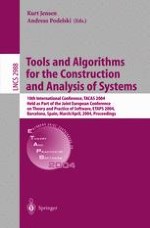2004 | OriginalPaper | Buchkapitel
How Vacuous Is Vacuous?
verfasst von : Arie Gurfinkel, Marsha Chechik
Erschienen in: Tools and Algorithms for the Construction and Analysis of Systems
Verlag: Springer Berlin Heidelberg
Enthalten in: Professional Book Archive
Aktivieren Sie unsere intelligente Suche, um passende Fachinhalte oder Patente zu finden.
Wählen Sie Textabschnitte aus um mit Künstlicher Intelligenz passenden Patente zu finden. powered by
Markieren Sie Textabschnitte, um KI-gestützt weitere passende Inhalte zu finden. powered by
Model-checking gained wide popularity for analyzing software and hardware systems. However, even when the desired property holds, the property or the model may still require fixing. For example, a property ϕ: “on all paths, a request is followed by an acknowledgment”, may hold because no requests have been generated. Vacuity detection has been proposed to address the above problem. This technique is able to determine that the above property ϕ is satisfied vacuously in systems where requests are never sent. Recent work in this area enabled the computation of interesting witnesses for the satisfaction of properties (in our case, those that satisfy ϕ and contain a request) and vacuity detection with respect to subformulas with single and multiple subformula occurrences.Often, the answer “vacuous” or “not vacuous”, provided by existing techniques, is insufficient. Instead, we want to identify all subformulas of a given CTL formula that cause its vacuity, or better, identify all maximal such subformulas. Further, these subformulas may be mutually vacuous. In this paper, we propose a framework for identifying a variety of degrees of vacuity, including mutual vacuity between different subformulas. We also cast vacuity detection as a multi-valued model-checking problem.
